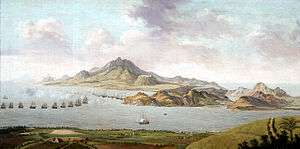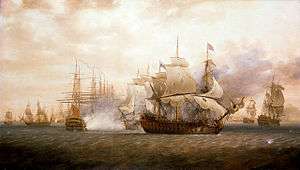Battle of Saint Kitts
The Battle of Saint Kitts, also known as the Battle of Frigate Bay, was a naval battle that took place on 25 and 26 January 1782 during the American Revolutionary War between a British fleet under Rear-Admiral Sir Samuel Hood and a larger French fleet under the Comte de Grasse.
Background
When Hood returned to the West Indies in late 1781 after the Battle of the Chesapeake, he was for a time in independent command owing to Rodney's absence in England. The French Admiral, the Comte de Grasse, attacked the British islands of Saint Kitts and Nevis, with 7000 troops and 50 warships, including the 110 gun Ville de Paris. He started by besieging the British fortress on Brimstone Hill on 11 Jan. 1782. Hood hoping to salvage, the situation made for St Kitts, departing Antigua on 22 Jan. with 22 ships of the line compared to De Grasse's 36.[4]
Action

The British fleet on 24 January consisted of twenty-two sail of the line, and was close off the south-east end of Nevis. They ran into and captured the French 16-gun cutter Espion which carried a large amount of ammunition for the besieging French forces at Brimstone Hill.
At daybreak on 25 January, the French fleet was discovered having stood to the southward of Basseterre, consisting of one 110 gun ship, twenty-eight two-decked ships, and two frigates. Hood stood towards the French fleet with the apparent intention of bringing on action, and effectively drew the French fleet off the land. No sooner had Hood effected this maneuver he was aided by a favourable change in wind and was able to guide his fleet within the anchorage of Basseterre, which the French admiral had just quit. Hood ordered his fleet in an L formation and then ordered his fleet to lay anchor. Comte de Grasse, in frustration made three distinct and vigorous attacks upon the British fleet on 26 January but was repulsed with great damage to his ships.[2]
The Pluton, commanded by D'Albert de Rions, lead the French line, "receiving the crashing broadside of ship after ship until the splintered planking flew from her off side and her rigging hung in a tangled mass." Chauvent goes on to describe the battle as "...a sulphurous hell, with cannon vomiting forth flame and death." The entire battle lasted from 7 AM to 6:30 PM, with the major action in the afternoon.[4]:97
Aftermath
Damages on both sides were heavy, though the French suffered higher casualties. However, Hood was unable to stop the French and could only observe the land action. After the successful French siege of Brimstone Hill fortress, St. Kitts and Nevis surrendered on 12 February.[4]:96–100
Hood left on the 14th and joined forces with the recently arrived Admiral George Rodney.
Order of battle
Britain
| Admiral Sir Samuel Hood's fleet | ||||||||
|---|---|---|---|---|---|---|---|---|
| Ship | Rate | Guns | Commander | Casualties | Notes | |||
| Killed | Wounded | Total | ||||||
| Van | ||||||||
| HMS St Albans | Third rate | 64 | Captain Charles Inglis | 0 |
0 |
0 |
||
| HMS Alcide | Third rate | 74 | Captain Charles Thompson | 2 |
4 |
6 |
||
| HMS Intrepid | Third rate | 64 | Captain Anthony James Pye Molloy | 2 |
0 |
2 |
||
| HMS Torbay | Third rate | 74 | Captain Lewis Gedoin | 0 |
0 |
0 |
||
| HMS Princessa | Third rate | 70 | Rear-Admiral Francis Samuel Drake Captain Charles Knatchbull |
2 |
4 |
6 |
Flagship of van | |
| HMS Prince George | Second rate | 98 | Captain James Williams | 1 |
3 |
4 |
||
| HMS Ajax | Third rate | 74 | Captain Nicholas Charrington | 1 |
12 |
13 |
||
| Centre | ||||||||
| HMS Prince William | Third rate | 64 | Captain George Wilkinson | 0 |
3 |
3 |
||
| HMS Shrewsbury | Third rate | 74 | Captain John Knight | 3 |
7 |
10 |
||
| HMS Invincible | Third rate | 74 | Captain Charles Saxton | 0 |
2 |
2 |
||
| HMS Barfleur | Second rate | 98 | Rear-Admiral Sir Samuel Hood Captain Alexander Hood |
9 |
24 |
33 |
Flagship of centre | |
| HMS Monarch | Third rate | 74 | Captain Francis Reynolds | 2 |
2 |
4 |
||
| HMS Belliqueux | Third rate | 64 | Captain Lord Cranstoun | 5 |
7 |
12 |
||
| HMS Centaur | Third rate | 74 | Captain John Nicholson Inglefield | 0 |
12 |
12 |
||
| HMS Alfred | Third rate | 74 | Captain William Bayne | 2 |
20 |
2 |
||
| Rear | ||||||||
| HMS Russell | Third rate | 74 | Captain Henry Edwyn Stanhope | 8 |
29 |
37 |
||
| HMS Resolution | Third rate | 74 | Captain Lord Robert Manners | 5 |
11 |
16 |
||
| HMS Bedford | Third rate | 74 | Rear Admiral Edmund Affleck Captain Thomas Graves |
2 |
15 |
17 |
Flagship of Rear | |
| HMS Canada | Third rate | 74 | Captain William Cornwallis | 1 |
12 |
13 |
||
| HMS Prudent | Third rate | 64 | Captain Andrew Barclay | 18 |
36 |
54 |
||
| HMS Montagu | Third rate | 74 | Captain George Bowen | 7 |
23 |
30 |
||
| HMS America | Third rate | 64 | Captain Samuel Thompson | 1 |
17 |
18 |
||
| Attached frigates | ||||||||
| Van | ||||||||
| HMS Eurydice | Sixth rate | 20 | Captain George Wilson | 0 |
0 |
0 |
||
| Centre | ||||||||
| HMS Pegasus | Sixth rate | 28 | Captain John Stanhope | 0 |
0 |
0 |
||
| HMS Fortunee | Sixth rate | 28 | Captain Hugh Cloberry Christian | 0 |
0 |
0 |
||
| HMS Lizard | Sixth rate | 28 | Captain Edmund Dod | 0 |
0 |
0 |
||
| HMS Champion | Sixth rate | 20 | Captain Thomas Wells | 1 |
1 |
2 |
To repeat signals | |
| HMS Convert | Fifth rate | 32 | Captain Henry Harvey | 0 |
0 |
0 |
||
| HMS Triton | Sixth rate | 28 | Captain John M’Lawrin | 0 |
0 |
0 |
||
| Rear | ||||||||
| HMS Sibyl | Sixth rate | 28 | Captain John Norton | 0 |
0 |
0 |
||
| HMS Solebay | Sixth rate | 28 | Captain Charles Everitt | 0 |
0 |
0 |
||
| Total recorded casualties: 72 killed, 244 wounded | ||||||||
| Source: Isaac Schomberg's Naval Chronology, pp. 396–7, The London Gazette, 9 March 1782.[5] | ||||||||
France
| Admiral the Comte de Grasse's fleet | ||||||||
|---|---|---|---|---|---|---|---|---|
| Ship | Guns | Commander | Fate | |||||
| Ville de Paris | 104 | François Joseph Paul de Grasse M. La Velleon |
||||||
| Auguste | 80 | Louis Antoine de Bougainville | ||||||
| Duc de Bourgogne | 80 | M. Espinouse | ||||||
| Couronne | 80 | Claude Mithon de Genouilly | ||||||
| Languedoc | 80 | M. d'Arros | ||||||
| Magnanime | 74 | Comte l'Basque | ||||||
| Northumberland | 74 | M de St. Cezaire | ||||||
| Pluton | 74 | M. d'Albert de Rions | ||||||
| Glorieux | 74 | Comte d'Escars | ||||||
| César | 74 | M. de Marigny | ||||||
| Hercule | 74 | M. la Clochetterie | ||||||
| Zélé | 74 | Chev. Gras Preville | ||||||
| Palmier | 74 | M. de Mortilly | ||||||
| Hector | 74 | M. le Vicomte | ||||||
| Souverain | 74 | M. de la Glendevis | ||||||
| Conquérant | 74 | M. de la Grandiere | ||||||
| Sceptre | 74 | Louis-Philippe de Vaudreuil | ||||||
| Citoyen | 74 | Comte d'Ethy | ||||||
| Destin | 74 | M. de Goimpy | ||||||
| Neptune | 74 | M. Destouches | ||||||
| Bourgogne | 74 | M. Champmartin | ||||||
| Dauphin Royal | 70 | M. Montpereux | ||||||
| Marseillais | 74 | Henri-César de Castellane Majastre[6] | ||||||
| Diadème | 74 | |||||||
| Éveillé | 64 | Comte Tilly | ||||||
| Réfléchi | 64 | Chev. de Boades | ||||||
| Jason | 64 | Chev. de Villages | ||||||
| Ardent | 64 | M. Groullon | ||||||
| Caton | 64 | Comte Fremont | ||||||
| Source: Isaac Schomberg's Naval Chronology, p. 398 | ||||||||
Notes
- ↑ Jaques, Hood arrived and repulsed de Grasse with victory at sea off Basseterre p. 881
- 1 2 Allen p. 325
- ↑ Marly p. 342
- 1 2 3 Hubbard, Vincent (2002). A History of St. Kitts. Macmillan Caribbean. pp. 95–96. ISBN 9780333747605.
- ↑ "No. 12277". The London Gazette. 9 March 1782. pp. 3–4.
- ↑ Batailles navales de la France, Onésime-Joachim Troude, Challamel ainé, 1867, vol.2, p. 215
References
- Allen, Joseph (1852). Battles of the British Navy. London: Henry Bohn. p. 325.
- Clowes, William Laird. The royal navy: a history from the earliest time to the present, Volume 3
- Jaques, Tony Dictionary of Battles and Sieges: A-E Greenwood 2006 ISBN 978-0-313-33536-5
- Marley, F. David. Wars of the Americas: A Chronology of Armed Conflict in the New World, 1492 to the Present ABC-CLIO (1998). ISBN 0-87436-837-5
- Schomberg, Isaac (1802). Naval Chronology:or, An Historical Summary of Naval & Maritime Events, From the Time of the Romans, to the Treaty of Peace, 1802. 4. London: T. Egerton by C. Roworth.
